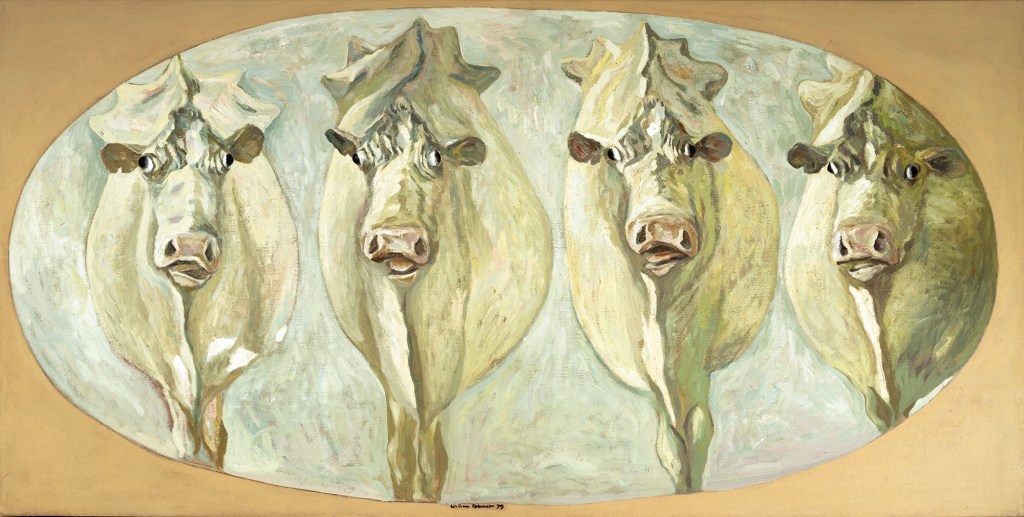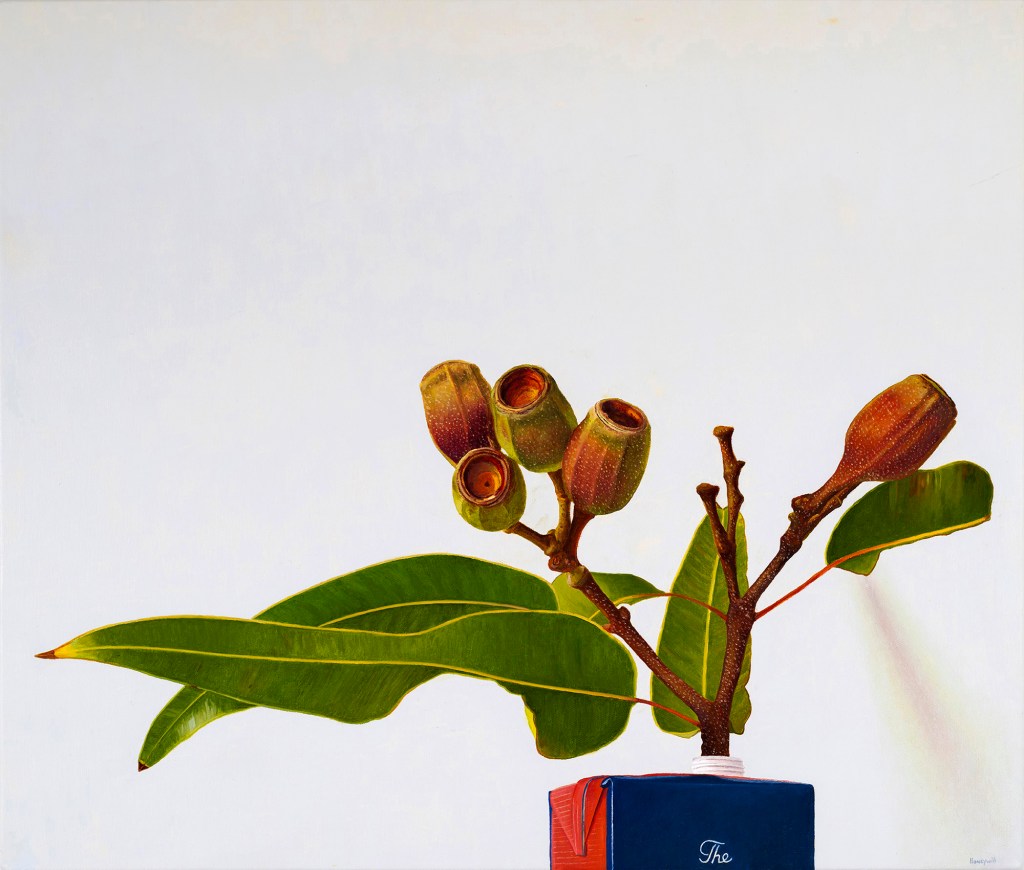Country comfort: Fun in the farmyard with William Robinson
William Robinson’s work can be grand and metaphysical but in his Farmyard series fun is the theme and that’s exactly what’s celebrated in his latest exhibition at Philip Bacon Galleries.

His landscapes are epic and transcendent, yet William Robinson’s oeuvre includes a series that is one of the most engaging in Australian art history.
That series is the focus of his latest exhibition at Philip Bacon Galleries in Fortitude Valley. Robinson, now in his 80s, is the gift that keeps on giving. And who knows of another artist who has had a museum dedicated to his work while still alive?
I refer to The William Robinson Gallery in Old Government House on the QUT campus at Garden’s Point. If you have visited or are a long-time fan you will know about his farmyard works.
William Robinson: Farmyards, Paintings, Pastels and Drawings at Philip Bacon’s eponymous gallery is dedicated to this charming and extensive strand of his work.
If, like me, you are lucky enough to know the artist, you understand that he is a wry humourist in his way, and his sense of fun is beautifully expressed in his farmyard works.
Born and raised in Brisbane, Robinson trained as a teacher and studied art at the Central Technical College (now QUT) in the 1950s, after which he began a distinguished career as a tertiary art educator in Brisbane and Toowoomba (including QUT). His students speak glowingly of his inspiring work as a teacher.
His painting practice continued alongside his teaching work. During the 1970s when the Robinsons lived on a small farm outside Brisbane, he began creating works that were inspired by 19th century French painter Pierre Bonnard and documented his surroundings, the interiors of his home and the day-to-day life of his growing family.
You might like
When they moved to a bigger property at Beechmont in the Gold Coast hinterland, he began painting farmyard scenes – jaunty pictures in which cows, goats, chickens and other animals cavort across the picture plane, often with minimal acknowledgement of realism or perspective. He included self-portraits and portraits of his wife Shirley in some of these works.
“Every place that we’ve ever lived has really affected my work,” Robinson has stated. “My work is a total reflection of my life, and these places have sometimes been difficult but they have been of extreme importance because they have given me an individuality … rather than a recipe which must be followed, or fashion or anything like that.”
‘Robinson had begun to paint farmyard images in the late 1970s and as with all the new developments in his artistic style these had their sources in both life and art’
The move to Beechmont also initiated Robinson’s engagement with the landscape and the magisterial works that followed are at the apex of of Australian landscape art. They are beautiful, poetic and moving.
But Robinson who is a dual Archibald and Wynne Prize winner, also likes to have fun and his farmyard series offered him that opportunity. In the 1995 publication William Robinson by Lynn Fern the author devotes a chapter, called The Whole Farmyard, to this series. An essay extracted from the book features in the current exhibition catalogue.
“Robinson had begun to paint farmyard images in the late 1970s and as with all the new developments in his artistic style these had their sources in both life and art,” Fern writes.
“In the scattered objects of the farmyard, he found possibilities for new compositional scatterings on his canvas. The real-life objects of the farmyard found a separate life as compositional elements. Juggling these new and different compositional forms was not a simple process and its development was not always even.

Subscribe for updates
“Robinson had begun this series of images simply by painting chickens. His response to the rich variety of the farmyard scene caused him to begin painting mixed groups of animals. These images are full of life, colour and a kind of zany humour that accepts and makes the most of the unceasing energy and disarray of farmyard life while still recognising it as a kind of microcosm of the world.”
The series is imbued with the love that underlies all the artist’s work. He embraces the world and his work can soar but at times but it can also bring us down to earth with that sense of humour so evident in his farmyard works.
There are early works included in this current show such as Chooks and ducks in the garden, 1979, but also more recent ones like Chooks in the sunflowers, painted in 2018, which shows the subject has stayed with him throughout his long career.

These are works that make you smile and I can’t think of another Australian artist who does anything even vaguely similar. Robinson has turned his attention to many subjects and in recent years he has turned his attention to his own lush garden, still-life works and a lovely series featuring Brisbane’s bayside.
As Lynn Fern points out: “The farm at Birkdale presented him with endless subject matter for his comic vision.”
“Yet these images are extremely complex,” she writes. “They incorporate perspectival shifts, the influence of Japanese woodblocks and the techniques of scattering and crowding. Element after element jostles for space on the canvas. It is part of the townsman’s humour that these elements consist of cows, goats, chooks, lean-tos, milking sheds and dunnies.”
He turned his attention eventually to the landscape itself with his paintings of mountains and forests of Queensland’s border ranges and you can enjoy works on that subject whenever you like if you visit the William Robinson Gallery.
But the farmyard works show another side to the master and it’s lovely to have an exhibition dedicated to them and a rare chance to purchase them. The prices on the larger works venture into six figures but there are still gems within reach with some of the drawings available for $12,500. The exhibition will attract serious collectors of Australian art. But it will also simply entertain those who just want to experience pure delight in art.

But wait! There’s more. While William Robinson is showing upstairs at the gallery downstairs there is a show by another much-loved Brisbane painter, John Honeywill.
His exquisite still-life works are masterful, warm and beyond aesthetically pleasing. He often turns his hand to confectionary or other sweet treats and Little Painting is the most gorgeous work within a work featuring … well I can’t quite work out if it’s a scone or a cupcake. I will have to inspect it more closely.
John Honeywill is a fine companion to William Robinson and that makes visiting the gallery a fulsome experience, to say the least.
William Robinson: Farmyards, Paintings, Pastels and Drawings and John Honeywill, Philip Bacon Galleries, Fortitude Valley, until August 16.
Free to share
This article may be shared online or in print under a Creative Commons licence

